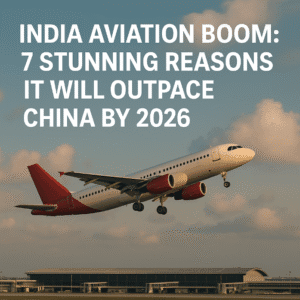India Aviation Boom: 7 Stunning Reasons It Will Outpace China by 2026
India is projected to surpass China as the fastest-growing air passenger market by 2026, driven by rapid infrastructure development and surging demand. While China leads with a 12% growth rate in 2025, India’s air traffic is expected to accelerate to 10.5% in 2026, outpacing China’s 8.9%, with this gap widening further by 2027. ACI Asia Pacific attributes India’s rise to its 159 operational airports, plans for 50 new airports by 2029, and record-breaking orders for 1,700+ aircraft by domestic airlines.
With just 0.1 annual air trips per capita (vs. China’s 0.5 and the U.S.’s 2.1), India’s untapped potential positions it as a long-term aviation leader, forecast to maintain a 5.5% annual growth rate through 2053—nearly double China’s 3.8%. Industry experts highlight India’s advantage in domestic travel expansion and emerging hub potential, though challenges like airport congestion and sustainability pressures persist. The bullish outlook has already boosted aviation stocks, reflecting confidence in India’s transformation into a global aviation powerhouse.
This shift signals a rebalancing of air travel’s future, anchored in India’s demographic and economic momentum.

India Aviation Boom: 7 Stunning Reasons It Will Outpace China by 2026
A seismic shift is underway in global aviation, with India poised to surpass China as the fastest-growing air passenger market by 2026. According to the Airports Council International (ACI), India’s aviation sector is accelerating rapidly, fueled by infrastructure expansion, rising demand, and untapped potential in a nation of 1.4 billion people. Here’s why this transition matters—and what it reveals about the future of air travel.
The Growth Race: India vs. China
While China currently leads with a 12% air passenger traffic growth rate in 2025, projections suggest India will overtake it the following year. By 2026, India’s growth is expected to hit 10.5%, edging past China’s 8.9%. This gap widens further by 2027, with India sustaining 10.3% growth against China’s 7.2%. Over the next three decades (2023–2053), India’s compound annual growth rate (CAGR) of 5.5% will far outpace China’s 3.8%, signaling a long-term realignment in aviation dominance.
Drivers of India’s Ascent
Infrastructure Expansion:
- India operates 159 airports today, with plans to add 50 more within five years. Major hubs like Delhi and Mumbai are undergoing modernization, while smaller cities gain connectivity through initiatives like the Regional Connectivity Scheme (UDAN). This expansion supports domestic travel, which accounts for 85% of India’s air traffic.
Fleet Modernization:
- Indian airlines have placed record orders for over 1,700 aircraft, including Air India’s historic 470-plane deal with Airbus and Boeing. These investments reflect confidence in meeting future demand, particularly as low-cost carriers like IndiGo and Akasa Air democratize air travel.
Untapped Potential:
- India’s air travel penetration remains strikingly low—just 0.1 annual trips per capita in 2023, compared to China’s 0.5 and the U.S.’s 2.1. Even by 2043, India is projected to reach only 0.4 trips per capita, leaving vast room for growth as incomes rise and fares become more accessible.
Industry Optimism and Challenges
SGK Kishore, President of ACI Asia Pacific & Middle East, predicts India will develop “major aviation hubs within 5–10 years,” driven by its large domestic market and strategic location connecting East and West. However, challenges persist:
- Infrastructure Bottlenecks: Congestion at major airports and delays in new projects could hinder growth.
- Regulatory Hurdles: High taxes on jet fuel and airport charges strain airline profitability.
- Sustainability Pressures: Balancing rapid growth with decarbonization goals remains critical.
Market Response and Global Context
The bullish outlook has already buoyed aviation stocks, with Interglobe Aviation (IndiGo) and GMR Airports seeing gains up to 5%. Meanwhile, other emerging markets like Indonesia (5.5% CAGR) and Vietnam (4.6%) are rising, but India’s scale sets it apart. By 2040, India could surpass the U.S. as the world’s third-largest air travel market, after China and the EU.
The Bigger Picture
India’s aviation boom mirrors its economic ascent. A growing middle class, urbanization, and e-commerce are reshaping travel patterns. For global airlines and manufacturers, India represents a rare high-growth frontier. As Stefano Baronci of ACI notes, “India isn’t just catching up—it’s building the foundation to lead.”
In contrast, China’s slowdown reflects market saturation and a post-pandemic focus on domestic tourism over international routes. India’s younger population and economic dynamism position it to redefine 21st-century air travel—provided it navigates infrastructure and policy challenges deftly.
For investors and travelers alike, India’s aviation story is one to watch: a nation taking flight, one runway at a time.
You must be logged in to post a comment.